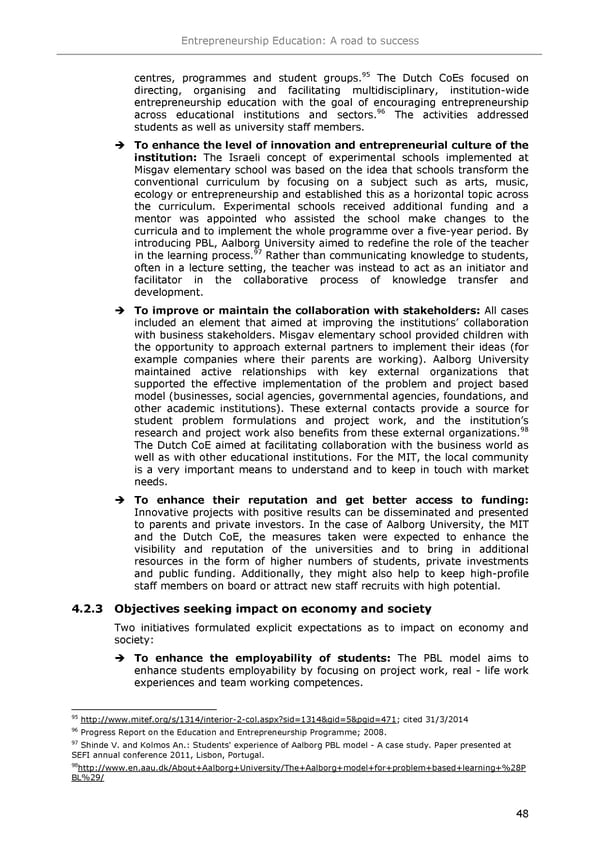Entrepreneurship Education: A road to success 95 centres, programmes and student groups. The Dutch CoEs focused on directing, organising and facilitating multidisciplinary, institution-wide entrepreneurship education with the goal of encouraging entrepreneurship 96 across educational institutions and sectors. The activities addressed students as well as university staff members. To enhance the level of innovation and entrepreneurial culture of the institution: The Israeli concept of experimental schools implemented at Misgav elementary school was based on the idea that schools transform the conventional curriculum by focusing on a subject such as arts, music, ecology or entrepreneurship and established this as a horizontal topic across the curriculum. Experimental schools received additional funding and a mentor was appointed who assisted the school make changes to the curricula and to implement the whole programme over a five-year period. By introducing PBL, Aalborg University aimed to redefine the role of the teacher 97 in the learning process. Rather than communicating knowledge to students, often in a lecture setting, the teacher was instead to act as an initiator and facilitator in the collaborative process of knowledge transfer and development. To improve or maintain the collaboration with stakeholders: All cases included an element that aimed at improving the institutions9 collaboration with business stakeholders. Misgav elementary school provided children with the opportunity to approach external partners to implement their ideas (for example companies where their parents are working). Aalborg University maintained active relationships with key external organizations that supported the effective implementation of the problem and project based model (businesses, social agencies, governmental agencies, foundations, and other academic institutions). These external contacts provide a source for student problem formulations and project work, and the institution9s research and project work also benefits from these external organizations.98 The Dutch CoE aimed at facilitating collaboration with the business world as well as with other educational institutions. For the MIT, the local community is a very important means to understand and to keep in touch with market needs. To enhance their reputation and get better access to funding: Innovative projects with positive results can be disseminated and presented to parents and private investors. In the case of Aalborg University, the MIT and the Dutch CoE, the measures taken were expected to enhance the visibility and reputation of the universities and to bring in additional resources in the form of higher numbers of students, private investments and public funding. Additionally, they might also help to keep high-profile staff members on board or attract new staff recruits with high potential. 4.2.3 Objectives seeking impact on economy and society Two initiatives formulated explicit expectations as to impact on economy and society: To enhance the employability of students: The PBL model aims to enhance students employability by focusing on project work, real - life work experiences and team working competences. 95 http://www.mitef.org/s/1314/interior-2-col.aspx?sid=1314&gid=5&pgid=471; cited 31/3/2014 96 Progress Report on the Education and Entrepreneurship Programme; 2008. 97 Shinde V. and Kolmos An.: Students' experience of Aalborg PBL model - A case study. Paper presented at SEFI annual conference 2011, Lisbon, Portugal. 98 http://www.en.aau.dk/About+Aalborg+University/The+Aalborg+model+for+problem+based+learning+%28P BL%29/ 48
 Entrepreneurship Education Page 51 Page 53
Entrepreneurship Education Page 51 Page 53